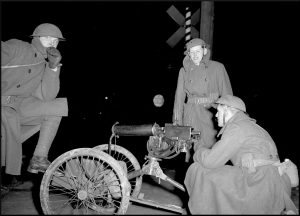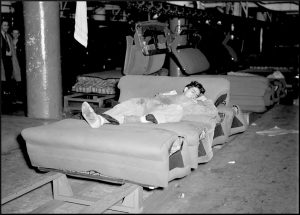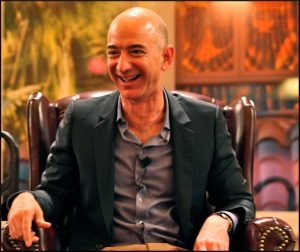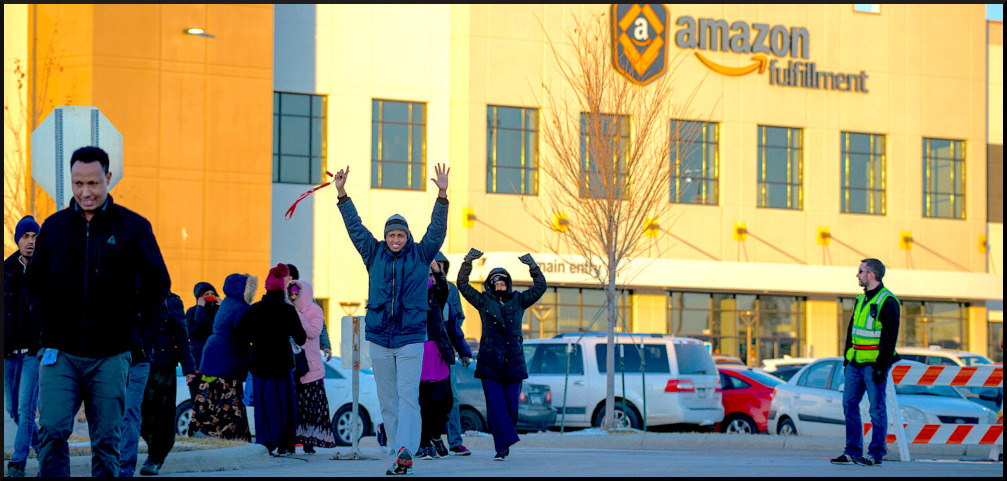by Sam Pizzigati, published on Consortium News, March 9, 2020
Most every morning this winter, starting about 3:30 a.m., pro-union workers have been gathering on a stretch of public sidewalk outside Amazon’s gigantic year-old warehouse in Bessemer, Alabama. They stand by a traffic light. They wait for the light to turn red — and the chance to urge their fellow Amazon workers to vote “yes” in the mail voting that’s going to decide whether they all get a union.
Amazon currently employs over half a million workers in the United States. Not a one of these employees has the protections of a union contract. Workers at Amazon’s Bessemer center are rising up early every morning to change that. Having a union at Amazon, they deeply believe, could make a real difference in their futures.
But not just Amazon workers figure to benefit from the outcome of the Bessemer balloting that ends later this month. The votes that Amazon’s Bessemer workers are casting could change the economic trajectory that has turned the United States — over the past half-century — into the world’s most unequal wealthy nation. Nothing that happens the rest of this year will likely do more to impact America’s unconscionably wide gap between rich and poor than how the Bessemer voting plays out.
“Unionization and the struggle here in Bessemer is important because it has the possibility of not only changing the lives of these workers here, but also of providing the courage to foster other battles and other struggles” –@mrdannyglover #BAmazonUnionhttps://t.co/0ZdfrAYkNc
— RWDSU (@RWDSU) March 5, 2021
What makes the union vote at Amazon so crucial to narrowing America’s vast economic divide? Let’s start with size. Amazon dominates the U.S. economy as no other corporation has dominated since General Motors ruled our nation’s economic roost in the middle of the 20th century.
Organizing GM

In the late 1930s, the American labor movement successfully organized General Motors with a dramatic sit-down campaign and that inspiring success triggered a huge increase in the unionized share of the American workforce. By the mid-1950s, some 35 percent of workers nationwide carried union cards. Union contracts came to set the wage standard, with many major nonunion employers — like the Sears retail chain — paying workers at going union rates.
Companies like Sears were making a sound business judgment. In a union labor environment, firms that don’t pay at levels that at least approach union rates simply can’t hire and keep all the workers they need. A vibrant labor movement, in effect, directly and indirectly “levels up” incomes of a society’s working population.
But “leveling up” won’t actually narrow a society’s gap between rich and poor if the rich are getting ever richer. Distinctly unequal societies only become substantially more equal if they both level up the bottom and level down the top. In the mid-20th-century United States, unions did just that.
This union role in leveling down America’s richest in the mid-20th century has largely gone unheralded. Commentators typically give the credit for that egalitarian achievement to the progressive income tax, and progressive taxes overall certainly did do yeoman egalitarian duty, as economists like Emmanuel Saez and Gabriel Zucman have so carefully detailed. Increases in progressive tax rates, their work shows, went hand in hand with decreases in the wealth share of America’s wealthiest.
In 1940, Americans in the nation’s richest 0.1 percent held 22 percent of the nation’s wealth. By the early 1970s that share had sunk to about 7 percent. Since then, the wealth share of the nation’s richest 0.1 percent has tripled back to the 20 percent level.

Tax rates on the rich have ridden the same roller coaster. They started rising in the 1930s, jumped significantly in the 1940s, and then remained significant for a generation. But then the dip began, and today’s rich have ended up sitting on record personal fortunes and paying precious little in taxes.
In 1951, Saez and Zucman calculate, Americans in the nation’s top 0.1 percent paid 61 percent of their income in local, state, and national taxes. By 2018, their effective tax rate had dropped to just over 30 percent.
The richest of America’s rich, a new Institute for Policy Studies analysis adds, have enjoyed an even starker tax bonanza. Between 1953 and 2018, their tax burden dropped a whopping 83 percent.
The Union Effect
Numbers like these help us understand how sinking tax rates have helped our rich become incredibly richer. But they don’t tell us why tax rates on the rich have sunk so steeply — or why they rose to robust levels before sinking. And that’s where America’s unions come in.
Throughout the 1930s and 1940s, the strength and savvy of America’s growing labor movement gave President Franklin Roosevelt the political base he needed to get the nation’s tax burden “equitably distributed according to ability to pay so that a few do not gain from the sacrifices of the many.”
The best example of this union role? Maybe the steep World War II hike in the federal tax rate on income in the nation’s highest income bracket. The big push for that hike started in April 1942 when FDR called for what amounted to a “maximum wage,” a 100 percent tax rate on individual income over $25,000, about $400,000 in today’s dollars.
Where did FDR’s idea come from? The New York Times gave that credit to the United Auto Workers, the fastest-growing affiliate of labor’s most progressive wing, the CIO. Other press reports would simply label the 100 percent top tax rate a CIO proposal.
Conservative congressional leaders and influential economists would quickly balk at Roosevelt’s bold call. The “only logical stopping place” for FDR’s push, charged Princeton’s Harley Lutz, would be “a completely communistic equalization of incomes.”
But FDR would keep pushing. In the end, he wouldn’t get his 100 percent top rate, but he did get a 94 percent top rate on income over $200,000, and the nation’s highest tax rate on top-bracket income would hover around 90 percent for the next two decades. Unions, particularly the new CIO industrial unions, would play a key role in this tax-the-rich success. In 1943, for instance, the CIO rallied a broad coalition — including the NAACP and a half-dozen other national groups — to blast conservatives in Congress for failing to adequately tax “high personal incomes.”
Tax-the-Rich Era Ended

This tax-the-rich era, unfortunately, would not last. Egalitarians had assumed that “redistribution” through progressive taxes would always “fix” whatever inequality our economy generated. But the rich, in real life, refused to cooperate with the fixing. In the 20th century’s last third, they pounded back against high tax rates and the labor movement that had done so much to put these high rates into effect.
Since 1963, the top tax rate on the dollars America’s rich pocket has dropped from 91 to 37 percent, and myriad loopholes have the richest of our rich paying less than 20 percent of their incomes in taxes.
The American labor movement has suffered an equally devastating statistical collapse. The share of private-sector workers who carry union cards has now dropped under 7 percent. Over large areas of the United States, the union movement has essentially no pulse.
What lesson should we take from all this? Redistribution alone can never be enough. We need to battle for an economy that generates less inequality in the first place. And that means working to identify the institutions and policies that funnel — that “pre-distribute” — excessive rewards to the already wealthy. For starters, that means taking on America’s major corporations.
Back in the mid-20th century, big-time corporate CEOs averaged no more than two- or three-dozen times what their workers took home. Today’s top corporate execs routinely “earn” several hundred times what their workers make. Outrageously lush rewards like these give executives an incentive to behave outrageously, to do whatever they feel they must to hit the corporate jackpot. They’ll downsize. They’ll outsource. They’ll even turn millions of Americans into opioid addicts.
Without a meaningful union presence in American life, our gap between the rich and everyone else has reached levels unimaginable a half-century ago. CEO pay at major corporations, the Economic Policy Institute points out, has soared a stunning 1,167 percent since 1978. Over that same four decades, typical worker compensation has inched up a microscopic 13.7 percent, on average just a fraction of 1 percent per year.
Unions today are energetically spotlighting this widening gap between corporate executive and worker pay. They’re backing proposals that would penalize corporations that pay their execs unconscionably more than their workers, by levying, for example, higher taxes on companies with CEO-worker pay gaps over 50- or 100-to-1. Other related proposals would grant firms with modest executive-worker pay gaps preferential treatment in the bidding for government contracts.
A number of states now have legislation pending that calls for these sorts of changes. Two cities — Portland and San Francisco — have actually adopted “pay ratio” plans along these lines. Leading progressives in Congress are backing similar bills.
Could measures like these ever gain an economic foothold? They certainly could — if the labor movement, here in the 21st century, regained a vigorous national presence. That presence could begin in Bessemer.
*Featured Image: Dec. 14, 2018: Amazon workers in Shakopee, Minnesota, protesting a variety of working conditions, such as being required to scan items at excessive rates of speed. (Fibonacci Blue, Flickr, CC BY 2.0)
Sam Pizzigati co-edits Inequality.org. His latest books include The Case for a Maximum Wage and The Rich Don’t Always Win: The Forgotten Triumph over Plutocracy that Created the American Middle Class, 1900-1970. Follow him at @Too_Much_Online.
This article is from Inequality.org.
